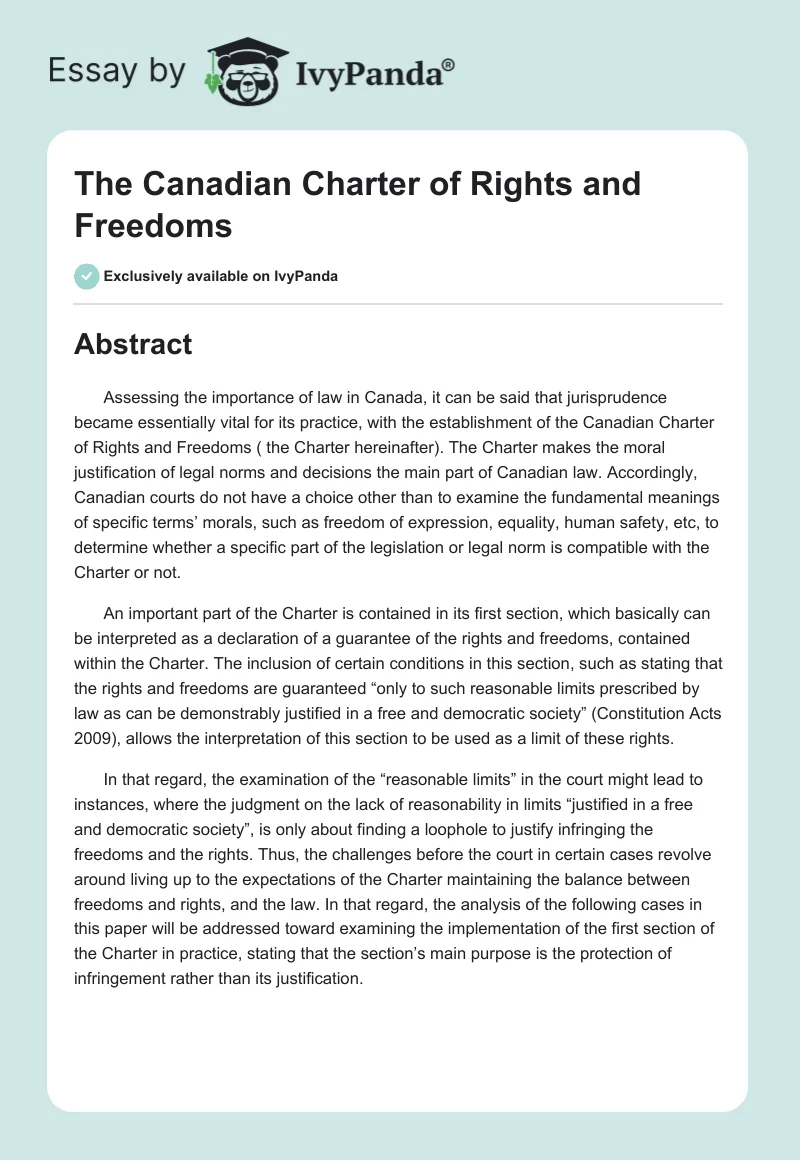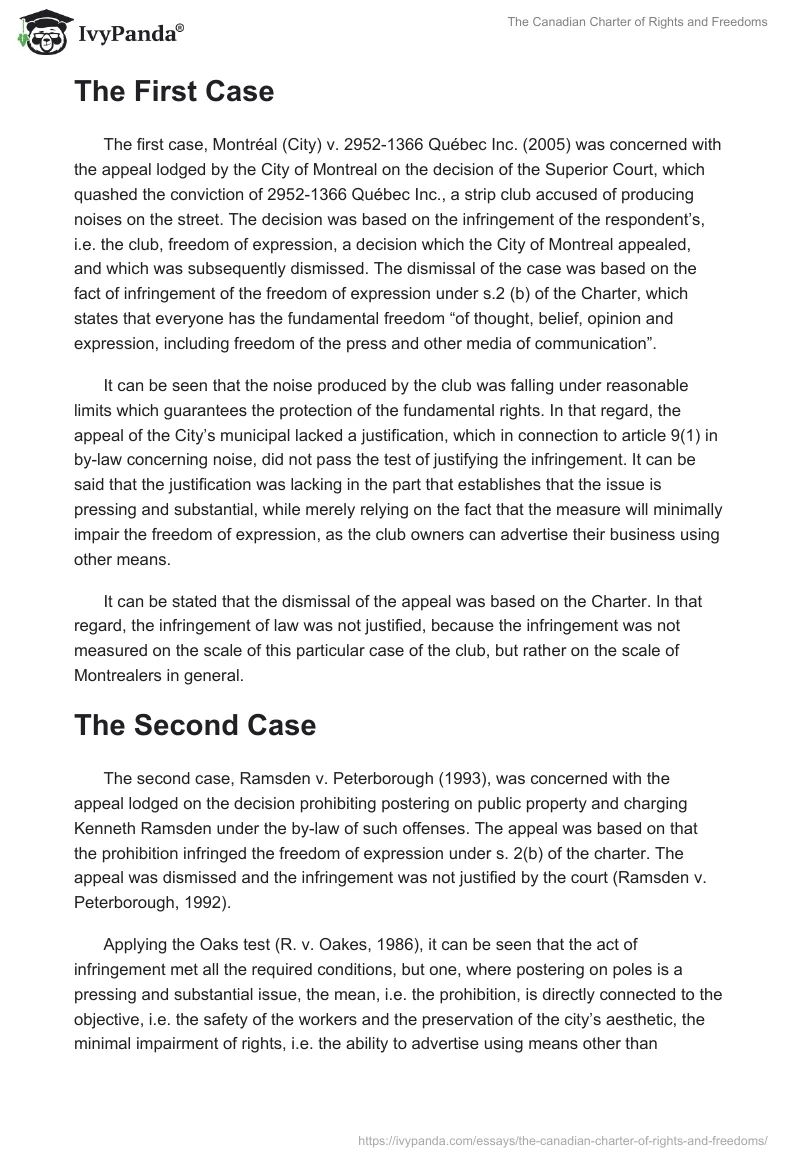Abstract
Assessing the importance of law in Canada, it can be said that jurisprudence became essentially vital for its practice, with the establishment of the Canadian Charter of Rights and Freedoms ( the Charter hereinafter). The Charter makes the moral justification of legal norms and decisions the main part of Canadian law. Accordingly, Canadian courts do not have a choice other than to examine the fundamental meanings of specific terms’ morals, such as freedom of expression, equality, human safety, etc, to determine whether a specific part of the legislation or legal norm is compatible with the Charter or not.
An important part of the Charter is contained in its first section, which basically can be interpreted as a declaration of a guarantee of the rights and freedoms, contained within the Charter. The inclusion of certain conditions in this section, such as stating that the rights and freedoms are guaranteed “only to such reasonable limits prescribed by law as can be demonstrably justified in a free and democratic society” (Constitution Acts 2009), allows the interpretation of this section to be used as a limit of these rights.
In that regard, the examination of the “reasonable limits” in the court might lead to instances, where the judgment on the lack of reasonability in limits “justified in a free and democratic society”, is only about finding a loophole to justify infringing the freedoms and the rights. Thus, the challenges before the court in certain cases revolve around living up to the expectations of the Charter maintaining the balance between freedoms and rights, and the law. In that regard, the analysis of the following cases in this paper will be addressed toward examining the implementation of the first section of the Charter in practice, stating that the section’s main purpose is the protection of infringement rather than its justification.
The First Case
The first case, Montréal (City) v. 2952-1366 Québec Inc. (2005) was concerned with the appeal lodged by the City of Montreal on the decision of the Superior Court, which quashed the conviction of 2952-1366 Québec Inc., a strip club accused of producing noises on the street. The decision was based on the infringement of the respondent’s, i.e. the club, freedom of expression, a decision which the City of Montreal appealed, and which was subsequently dismissed. The dismissal of the case was based on the fact of infringement of the freedom of expression under s.2 (b) of the Charter, which states that everyone has the fundamental freedom “of thought, belief, opinion and expression, including freedom of the press and other media of communication”.
It can be seen that the noise produced by the club was falling under reasonable limits which guarantees the protection of the fundamental rights. In that regard, the appeal of the City’s municipal lacked a justification, which in connection to article 9(1) in by‑law concerning noise, did not pass the test of justifying the infringement. It can be said that the justification was lacking in the part that establishes that the issue is pressing and substantial, while merely relying on the fact that the measure will minimally impair the freedom of expression, as the club owners can advertise their business using other means.
It can be stated that the dismissal of the appeal was based on the Charter. In that regard, the infringement of law was not justified, because the infringement was not measured on the scale of this particular case of the club, but rather on the scale of Montrealers in general.
The Second Case
The second case, Ramsden v. Peterborough (1993), was concerned with the appeal lodged on the decision prohibiting postering on public property and charging Kenneth Ramsden under the by-law of such offenses. The appeal was based on that the prohibition infringed the freedom of expression under s. 2(b) of the charter. The appeal was dismissed and the infringement was not justified by the court (Ramsden v. Peterborough, 1992).
Applying the Oaks test (R. v. Oakes, 1986), it can be seen that the act of infringement met all the required conditions, but one, where postering on poles is a pressing and substantial issue, the mean, i.e. the prohibition, is directly connected to the objective, i.e. the safety of the workers and the preservation of the city’s aesthetic, the minimal impairment of rights, i.e. the ability to advertise using means other than postering on poles. The condition which was missing was related to the proportionality of infringement and the objective.
In that regard, it can be stated that the infringement of the rights cannot be justified in favor of safety issues, social concerns, and the preservation of the visual style of the city. It should be mentioned that the measurement of proportionality could be applied in the case, and which shows the extent of infringing on the long term. It can be seen that in case the right was not infringed, the lawsuit can be used as a precedent in issues related to freedom of visual expression on properties.
On the other hand, the infringement of the right and the complete ban on the visual expression would extend to “trees, all types of poles, and all other public property” (Ramsden v. Peterborough, 1993). Accordingly, it can be seen that the second case used section one of the Charter to control and limit the infringement, rather than the opposite.
The Third Case
In Multani v. Commission scolaire Marguerite‑Bourgeoys (2007), the case was related to the infringement of the fundamental right under s. 2(a) of the Charter, which is the freedom of expression. The case revolved around the appeal lodged by Balvir Singh Multani and his son, both are orthodox Sikhs, whose religion requires them to wear a kirpan, a religious object, and a dagger, all of the time. An initial agreement was held between the school and Multani, allowing his son to wear the kirpan at school, provided that he sealed it while being there. The agreement was not ratified by the school board, to which Multani appealed on the basis that the actions of the school board infringed the Charter of rights. The appeal was allowed, as the infringement was not justified.
Applying the Oaks test, it can be seen that the missing condition is the minimal impairment of the rights, where the measure was of big significance to Multani’s son, through either abandoning a significant religious practice or missing the school. Accordingly, it was stated in the case that the board did not examine the reasonableness of the limits indicated in the first section of the charter, where the agreement on wearing the kirpan under certain conditions was a solution that was met upon, and which the board did not consider. It can be stated that the infringement of the right was not justified, and accordingly, the ruling of the court, in this case, can be considered objective. Thus, the third case also used the first section of the Charter to limit the infringement of rights by law, or in this case, by an administrative decision.
The Fourth Case
In the fourth case, R. v. Butler (1992), the main issue was related to the appeal lodged by Donald Victor Butler stating that the right to possess obscene material is protected under the s.2 (b) of the Charter, a right that was infringed by section 163 of the Criminal code, based on which he was accused and convicted (R. v. Butler, 1992). The court upheld the decision that the rights were infringed, but justified under s. 1 of the Charter.
The application of the Oaks test outlines the main condition to consider in this case, which is the issue being of pressing and substantial concern for society. Accordingly, the link between the mean and the objective was established, the infringement and the objective were proportional and there was minimal impairment of rights in the case. The point of controversy might be seen in the classification of the obscene material as a terminology, while other than that, the condition of minimal impairment should be met with other materials, which did not fall into the category. Accordingly, it can be stated that the infringement of a right, in this case, was justifiable, with the court ruling an objective decision.
It can be concluded from the four cases, that the standards of justification of an infringement are high to be easily met. In that sense, it can be stated that section one of the Canadian Charter of Rights and Freedoms is mainly used to protect the rights, rather than justifying their infringements. The cases in which the infringement of the government was justified turned into landmark cases such as the case R. v. Butler (1992). In the majority of cases, the Charter served its purpose perfectly, providing a guarantee of protection of rights and freedoms.
Class Action Lawsuit
Outlining the purposes of the class actions lawsuits, it can be stated that the rise of such phenomenon put the question of their practices and outcomes in a perspective that complicates the process of their differentiation. In that regard, it is stated that class actions lawsuits involving small-dollar claims “pose multiple dilemmas for public policy” (Hensler and Institute for Civil Justice (U.S.) 119). One such dilemma is that with the rise of such cases and the corresponding rise of the number of compensations, resulted in a shift from a useful social purpose of the lawsuits toward opportunity gains from the financial incentives through these cases. In that regard, this paper briefly analyses the type of class action lawsuit, and its inclination toward public policy or financial gains, based on the Ticketmaster class action lawsuit.
The lawsuit is based on the allegations that Ticketmaster, a ticket sale and distribution company, was redirecting their customer to subsidiary brokers, which were charging higher prices on ticket sales (FindLaw). People with the same kind of damages might be able to join the suit, provided they fulfilled several conditions related to the date of their visit to the website service and the date of the purchase. It can be seen that such lawsuits can be classified as cases that arise as individual litigation, and are later aggregated. These cases can be seen as damage class actions and are epitomized by mass personal injury and property damage suits (Hensler and Institute for Civil Justice (U.S.) 67).
In that regard, such cases are mainly concerned with possible gains, with little emphasis on regulations. Drawing a parallel to Ticketmaster, the consequences might lead to compensating the charges of the customers, with no regulatory effect or framework for the regulation of online transactions by private companies. This can be also caused by the fact that the damage itself is based only on one dimension, which is the financial dimension. The scale of the case might have increased due to the enormous population of online consumers. Additionally, it is stated that to influence public policies, the best solution is to draw two systems of enforcement, the administrative law, and private class actions. Thus, in the Ticketmaster case, for regulation to take place, an administrative lawsuit should be filed in parallel.
Works Cited
“Constitution Acts, 1867 to 1982”. 2009. Canada Department of Justice 2009. Web.
FindLaw. “Ticketmaster Faces Class Action Lawsuit over Online Ticket Sales”. 2009. FindLaw. Web.
Hensler, Deborah R., and Institute for Civil Justice (U.S.). Class Action Dilemmas: Pursuing Public Goals for Private Gain. Santa Monica, CA: Rand, 2000. Print.
Montréal (City) v. 2952-1366 Québec Inc., [2005] 3 S.C.R. 141, 2005 SCC 62. Web.
Multani v. Commission scolaire Marguerite‑Bourgeoys, [2006] 1 S.C.R. 256, 2006 SCC 6. Web.
R. v. Butler, [1992] 1 S.C.R. 452. 2009. Web.
R. v. Oakes, [1986] 1 S.C.R. 103. 2009. Web.
Ramsden v. Peterborough (City), [1993] 2 S.C.R. 1084. 2009. Web.


